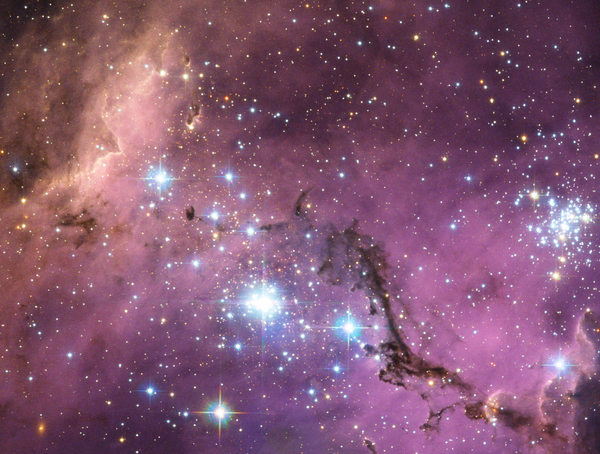Latest Hubble measurements suggest disparity in Hubble constant calculations is not a fluke [heic1908]
25 April 2019
Hubble's measurements of today's expansion rate do not match the rate that was expected based on how the Universe appeared shortly after the Big Bang over 13 billion years ago. Using new data from the NASA/ESA Hubble Space Telescope, astronomers have significantly lowered the possibility that this discrepancy is a fluke. |
| LHA 120-N11 in the Large Magellanic Cloud. Credit: NASA, ESA. Acknowledgement: Josh Lake |
Using new observations from the NASA/ESA Hubble Space Telescope, researchers have improved the foundations of the cosmic distance ladder, which is used to calculate accurate distances to nearby galaxies. This was done by observing pulsating stars called Cepheid variables in a neighbouring satellite galaxy known as the Large Magellanic Cloud, now calculated to be 162 000 light-years away. When defining the distances to galaxies that are further and further away, these Cepheid variables are used as milepost markers. Researchers use these measurements to determine how fast the Universe is expanding over time, a value known as the Hubble constant.
Before Hubble was launched in 1990, estimates of the Hubble constant varied by a factor of two. In the late 1990s the Hubble Space Telescope Key Project on the Extragalactic Distance Scale refined the value of the Hubble constant to within 10 percent, accomplishing one of the telescope's key goals. In 2016, astronomers using Hubble discovered that the Universe is expanding between five and nine percent faster than previously calculated by refining the measurement of the Hubble constant and further reducing the uncertainty to only 2.4 percent. In 2017, an independent measurement supported these results. This latest research has reduced the uncertainty in their Hubble constant value to an unprecedented 1.9 percent.
This research also suggests that the likelihood that this discrepancy between measurements of today's expansion rate of the Universe and the expected value based on the early Universe's expansion is a fluke is just 1 in 100 000, a significant improvement from a previous estimate last year of 1 in 3000.
"The Hubble tension between the early and late Universe may be the most exciting development in cosmology in decades," said lead researcher and Nobel Laureate Adam Riess of the Space Telescope Science Institute (STScI) and Johns Hopkins University, in Baltimore, USA. "This mismatch has been growing and has now reached a point that is really impossible to dismiss as a fluke. This disparity could not plausibly occur by chance."
As the team's measurements have become more precise, their calculation of the Hubble constant has remained inconsistent with the expected value derived from observations of the early Universe's expansion made by the European Space Agency's Planck satellite. These measurements map a remnant afterglow from the Big Bang known as the Cosmic Microwave Background, which help scientists to predict how the early Universe would likely have evolved into the expansion rate astronomers can measure today.
The new estimate of the Hubble constant is 74.03 kilometres per second per megaparsec [1]. The number indicates that the Universe is expanding at a rate about 9 percent faster than that implied by Planck's observations of the early Universe, which give a value for the Hubble constant of 67.4 kilometres per second per megaparsec.
To reach this conclusion, Riess and his team analysed the light from 70 Cepheid variables in the Large Magellanic Cloud. Because these stars brighten and dim at predictable rates, and the periods of these variations give us their luminosity and hence distance, astronomers use them as cosmic mileposts. Riess's team used an efficient observing technique called Drift And Shift (DASH) using Hubble as a "point-and-shoot" camera to snap quick images of the bright stars. This avoids the more time-consuming step of anchoring the telescope with guide stars to observe each star. The results were combined with observations made by the Araucaria Project, a collaboration between astronomers from institutions in Europe, Chile, and the United States, to measure the distance to the Large Magellanic Cloud by observing the dimming of light as one star passes in front of its partner in a binary-star system.
Because cosmological models suggest that observed values of the expansion of the Universe should be the same as those determined from the Cosmic Microwave Background, new physics may be needed to explain the disparity. "Previously, theorists would say to me, 'it can't be. It's going to break everything.' Now they are saying, 'we actually could do this,'" Riess said.
Various scenarios have been proposed to explain the discrepancy, but there is yet to be a conclusive answer. An invisible form of matter called dark matter may interact more strongly with normal matter than astronomers previously thought. Or perhaps dark energy, an unknown form of energy that pervades space, is responsible for accelerating the expansion of the Universe.
Although Riess does not have an answer to this perplexing disparity, he and his team intend to continue using Hubble to reduce the uncertainty in their measure of the Hubble constant, which they hope to decrease to 1 percent.
The team's results have been accepted for publication in The Astrophysical Journal.
Notes
[1] This means that for every 3.3 million light-years further away a galaxy is from us, it appears to be moving about 74 kilometres per second faster, as a result of the expansion of the Universe.
More information
The Hubble Space Telescope is a project of international cooperation between ESA and NASA.
The team of astronomers in this study consists of Adam G. Riess (Johns Hopkins University, USA; STScI, USA), Stefano Casertano (STScI, USA), Wenlong Yuan (Johns Hopkins University, USA), Lucas M. Macri (Texas A&M University, USA), Dan Scolnic (Duke University, USA)
Contacts
Adam Riess
Space Telescope Science Institute
Baltimore, USA
Tel: +1 410 338 6707
Email: ariess![]() stsci.edu
stsci.edu
Bethany Downer
ESA/Hubble, Public Information Officer
Garching, Germany
Email: bethany.downer![]() partner.eso.org
partner.eso.org


